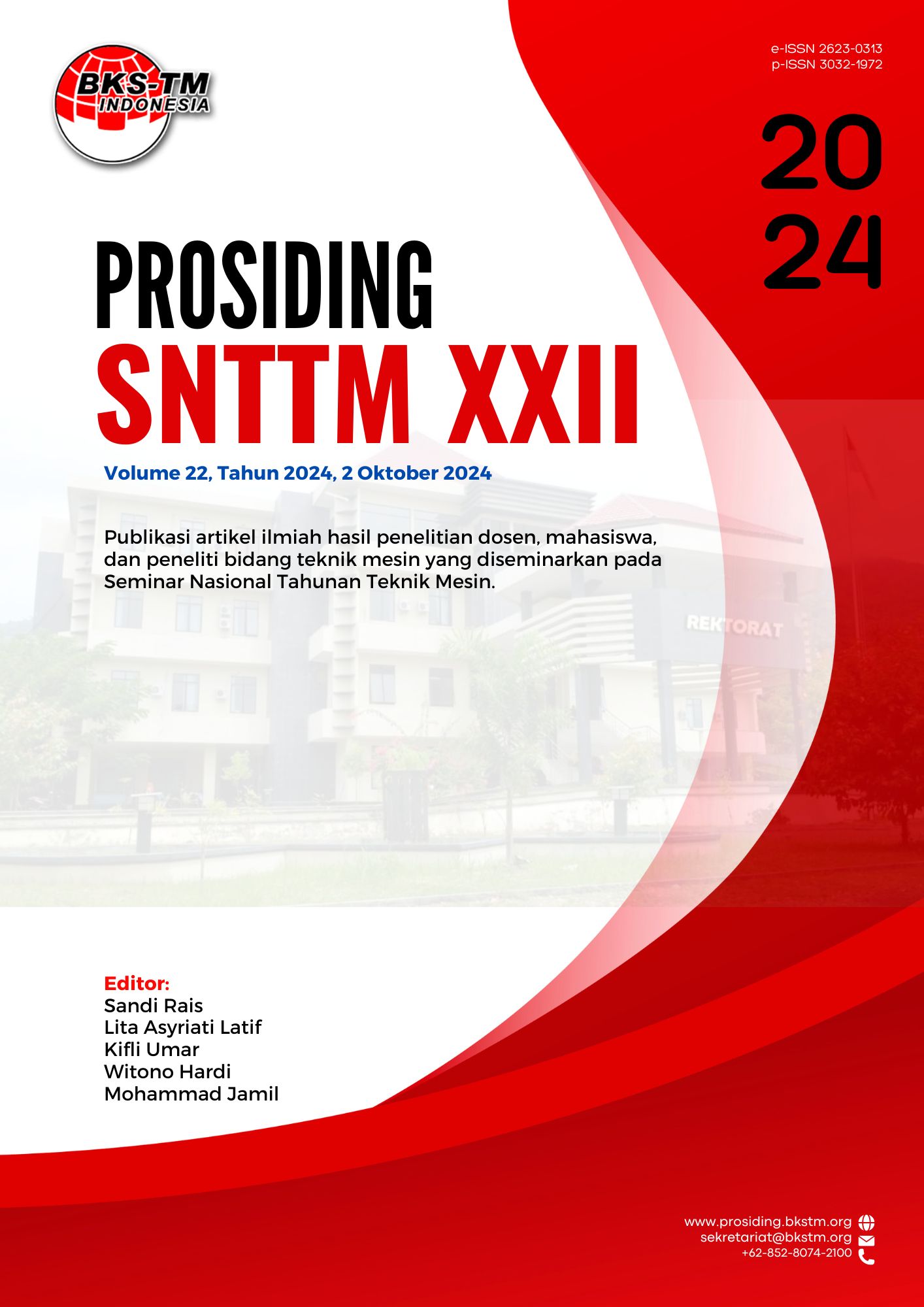Biochar and Energy Production from Rice Husk and Corncob in Karawang: A Techno-Enviro Analysis
DOI:
https://doi.org/10.71452/590795Keywords:
Co-gasification; LCA; Aspen plus; Global Warming Potential;Abstract
The world is facing increasing challenges in sustainable energy production and waste management. This study presents a techno-environmental analysis of biochar and energy production from rice husks and corncob in Karawang, Indonesia, through co-gasification. A parametric study using Aspen Plus simulation shows that biochar yield is sensitive to temperature and equivalence ratio (ER). Specifically, corncob gasification at 450 degrees Celsius yields the highest amount of biochar. Additionally, the study finds that increases in temperature and ER lead to higher syngas and lower heating value (LHV). A life cycle assessment was conducted to evaluate three scenarios: 100% rice husk, 100% corn cob, and a 50% combination of rice husk and corncob for biochar application as carbon sequester. The findings indicate that the 50% mixing ratio has the most positive impact on global warming potential, with a carbon offset of - 170,134 kg CO2eq per 1000 kg of biochar applied to soil. The results provide valuable insights into environmental impacts of utilizing these agricultural residues for renewable energy generation and biochar production.
References
Basu, P. (2010). Biomass gasification and pyrolysis: practical design and theory. Academic Press.
Bhurse, R. R., Gope, P. P., Yadav, H., Prasad, K. R., & Chaurasia, A. S. (2024). Syngas and hydrogen production from co-gasification of rice husk biomass and plastic waste mixture using Aspen Plus. Environment, Development, and Sustainability. https://doi.org/10.1007/s10668-024-04571-z
BPS. (2021). Luas Panen dan Produksi Padi di Indonesia 2021.
BPS Karawang. (2016). Produksi (Ton) Jagung Di Kabupaten Karawang Tahun 2010-2015.
FAO. (2011). The Water-Energy-Food Nexus A new approach in support of food security and sustainable agriculture.
FAO, & ITPS. (2015). Status of the World’s Soil Resources Main report.
Fawzy, S., Osman, A. I., Mehta, N., Moran, D., Al-Muhtaseb, A. H., & Rooney, D. W. (2022). Atmospheric carbon removal via industrial biochar systems: A techno-economic-environmental study. Journal of Cleaner Production, 371, 133660. https://doi.org/10.1016/j.jclepro.2022.133660
Gani, A., Adisalamun, Arkan D., M. R., Suhendrayatna, Reza, M., Erdiwansyah, Saiful, & Desvita, H. (2023). Proximate and ultimate analysis of corncob biomass waste as raw material for biocoke fuel production. Case Studies in Chemical and Environmental Engineering, 8. https://doi.org/10.1016/j.cscee.2023.100525
Giusti, G., Almeida, G. F. de, Apresentação, M. J. de F. de, Galvão, L. S., Knudsen, M. T., Djomo, S. N., & Silva, D. A. L. (2023). Environmental impacts management of grain and sweet maize through life cycle assessment in São Paulo, Brazil. International Journal of Environmental Science and Technology, 20(6), 6559–6574. https://doi.org/10.1007/s13762-022-04418-y
Huang, C., Mohamed, B. A., & Li, L. Y. (2023). Comparative life-cycle energy and environmental analysis of sewage sludge and biomass co-pyrolysis for biofuel and biochar production. Chemical Engineering Journal, 457, 141284. https://doi.org/10.1016/j.cej.2023.141284
Imtiaz Anando, A., Ehsan, M. M., Karim, M. R., Bhuiyan, A. A., Ahiduzzaman, M., & Karim, A. (2023). Thermochemical pretreatments to improve the fuel properties of rice husk: A review. Renewable Energy, 215, 118917. https://doi.org/10.1016/j.renene.2023.118917
Kumar Mishra, R., Jaya Prasanna Kumar, D., Narula, A., Minnat Christie, S., & Ullhas Naik, S. (2023). Production and beneficial
impact of biochar for environmental application: A review on types of feedstocks, chemical compositions, operating parameters, techno-economic study, and life cycle assessment. Fuel, 343, 127968. https://doi.org/10.1016/j.fuel.2023.127968
Lan, W., Chen, G., Zhu, X., Wang, X., Liu, C., & Xu, B. (2018). Biomass gasification-gas turbine combustion for a power generation system model based on ASPEN PLUS. Science of The Total Environment, 628–629, 1278–1286. https://doi.org/10.1016/j.scitotenv.2018.02.159
Lehmann, J., & Joseph, S. (2009). Biochar for Environmental Management: An Introduction. In Biochar for Environmental Management Science and Technology (pp. 1–9). Earthscan.
Marzeddu, S., Cappelli, A., Ambrosio, A., Décima, M. A., Viotti, P., & Boni, M. R. (2021). A Life Cycle Assessment of an Energy-Biochar Chain Involving a Gasification Plant in Italy. Land, 10(11), 1256. https://doi.org/10.3390/land10111256
Peanparkdee, M., & Iwamoto, S. (2019). Bioactive compounds from rice cultivation and processing by-products: Extraction and application in the food and pharmaceutical industries. Trends in Food Science & Technology, 86, 109–117. https://doi.org/10.1016/j.tifs.2019.02.041
Pertiwi, S., Bobby, Y., Lorenzo, M., Dafiqurrohman, H., & Surjosatyo, A. (2022). Mobile Rice Husk Gasifier Performance and Techno-Economic Analysis as Micro Scale Power Generation: Modeling and Experiment. Journal of Engineering and Technological Sciences, 54(6), 220608. https://doi.org/10.5614/j.eng.technol.sci.2022.54.6.8
Pranolo, S. H., Waluyo, J., Putro, F. A., Adnan, M. A., & Kibria, M. G. (2023). Gasification process of palm kernel shell to fuel gas: Pilot-scale experiment and life cycle analysis. International Journal of Hydrogen Energy, 48(7), 2835–2848. https://doi.org/10.1016/j.ijhydene.2022.10.066
Rosha, P., & Ibrahim, H. (2022). Technical feasibility of biomass and paper-mill sludge co-gasification for renewable fuel production using Aspen Plus. Energy, 258, 124883. https://doi.org/10.1016/j.energy.2022.124883
Santolini, E., Barbaresi, A., Bovo, M., Torreggiani, D., & Tassinari, P. (2022). Life cycle assessment of the supply chain processes for the valorization of corn cob. Transportation Research Procedia, 67, 93–99. https://doi.org/10.1016/j.trpro.2022.12.039
Shafie, S. M., T. M. I. Mahlia, Masjuki, H. H., & Rismanchi, B. (2012). Life cycle assessment (LCA) of electricity generation from rice husk in Malaysia. Energy Procedia, 14, 499–504. https://doi.org/10.1016/j.egypro.2011.12.965
Thapar Kapoor, R., & Shah, M. P. (n.d.). Designer Biochar-Assisted Bioremediation of Industrial Effluents: A Low-Cost Sustainable Green Technology.
Turns, S. R. (2001). An introduction to combustion: Concepts and application. McGraw Hill Publishers.
Vikram, S., Rosha, P., & Kumar, S. (2021). Recent Modeling Approaches to Biomass Pyrolysis: A Review. Energy & Fuels, 35(9), 7406–7433. https://doi.org/10.1021/acs.energyfuels.1c00251
Zhang, Y., Wang, J., & Feng, Y. (2021). The effects of biochar addition on soil physicochemical properties: A review. CATENA, 202, 105284. https://doi.org/10.1016/j.catena.2021.105284
Zhang, Z., Zhu, Z., Shen, B., & Liu, L. (2019). Insights into biochar and hydrochar production and applications: A review. Energy, 171, 581–598. https://doi.org/10.1016/j.energy.2019.01.035
Downloads
Published
Conference Proceedings Volume
Section
License
Copyright (c) 2025 Gabriella A L Siantar, Adi Surjosatyo (Author)

This work is licensed under a Creative Commons Attribution-NonCommercial 4.0 International License.
Proceeding SNTTM by BKS-TM Indonesia is licensed under Creative Commons Attribution 4.0 International





